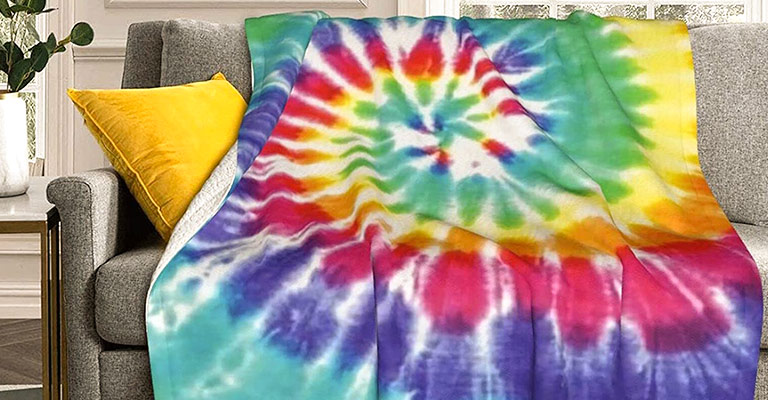In most cases, if you buy any clothing with microfiber, it will come with a flat-colored design. So, chances are you get bored with the color of your microfiber clothing after using it for some days. Besides, using out-of-fashion designs for your microfiber fabric won’t give you a good feeling.

At this point, you may start to think about tie-dyeing your microfiber products. But, can you tie-dye microfiber for real? Don’t worry, we have put together all the information you need in this article to help you understand. Without further delay, we will get to the main point.
What Is Microfiber?
In a simple sense, microfiber is a very fine synthetic yarn. To be specific, it is actually a type of lining fabric yarn that is used to make output fabric. Surprisingly, microfiber is many times smaller than human hair because of its thin polyester and nylon fiber. Since this fiber is too small, you can consider microfiber as a germ removal superior tool which can clean very finely using a polyamide structure.
The major benefit of microfiber fabric is its usability. Suppose you compare microfiber and paper towels or cotton cloths. In that case, only the microfiber can penetrate crevasses and cracks that deep and clean small particles by reaching the highest peak. However, some people don’t like plastic microfibers due to their environmental pollution and it can cause inflammation inside the human lungs.
Can You Tie Dye Microfiber – Is It Possible?
Generally, you can tie-dye most of the fabrics. And, identically, the microfiber fabric is also a member of the same family with very small fibers of different materials. So, theoretically, it is possible to tie-dye microfiber. However, you must know what materials are used to make a specific microfiber to understand how you can tie-dye a specific microfiber.
Whatever method you use to tie-dye microfiber, you always need patience and a little bit of extra time as you cannot dye such tiny fiber in a simple way. You’ll be sad to know, a type of microfiber called polypropylene refuses to take most dyes. So, your tie-dyeing may not work the same for different microfibers.
Always get a high-quality dye that can produce a high level of colorfastness. Because tie-dyeing polyester microfiber using a normal or natural dye is not possible. So, maximum color fastness ensures that color blending is going on in a proper way.
We can suggest some other alternatives. Though these methods are not directly considered tie-dyeing, the result is the same. For example, you can use actual paints to paint on the microfiber fabric or use a crayon to paint on the surface of the clothing. Considering all these things, one thing is clear: you should follow different ways to tie-dye microfiber. Now, let’s see the type-based tie-dyeing methods.
1. Polypropylene Microfiber
We’ve already mentioned this microfiber, which comes with tightly bound fibers. Because of the tight structure among the fibers, it is quite impossible to tie-dye the polypropylene microfiber. If you still want to dye such material, you should go for another method of dyeing, not tie dye. However, you need an advanced dyeing process to apply other methods too.
2. Polyester Microfiber
Polyester is very common among all microfiber types. As a result, its dye is also widely available. Specifically, you can use dispersed dyes to tie-dye this microfiber fabric. But, don’t forget that you need to choose dyes that have a very high level of fastness. Otherwise, you won’t get a good result.
3. Nylon Microfiber
Another popular type of microfiber is nylon. This fabric is also found in microfiber-based clothing. The interesting fact is that you can only use acid dyes on nylon. So, in a similar way, all nylon fabrics, as well as microfiber types, need acid dyes for tie-dyeing properly. Also, you should consider choosing a dye that has better fastness capability.
Frequently Asked Questions and Answers (FAQs)
Are Microsuede And Microfiber The Same Thing?
Actually, micro suede is a type of microfiber. To clarify, micro suede is made up using very small microfibers bound together to create a sheet of synthetic cloth. That means you can call microsuede a microfiber. However, all microfibers are not the same. There are other microfibers made using other materials, which are not the same as micro suede. So, you can never mention all microfibers as microsuede.
Why Is It Hard To Dye Microfiber?
You know that synthetic fabrics lose their color very quickly to the sun and other elements. Besides, these fabrics cannot absorb color at the same rate as natural fabrics. So, you will always find it difficult to dye microfiber. When talking about microfiber, it is more complicated due to very small fibers packed together, and the surface area of dyeing is a lot bigger than previously. Therefore, dyeing is not only difficult here but also impossible sometimes.
Can I Use Any Kind Of Dye For Microfiber?
No, you cannot. Because microfiber is made with a compound setup of small fibers. Sometimes, you may get different fibers mixed in this synthetic setup. As a result, you cannot use natural or normal dye here. Even some strong dyes don’t work in such a condition for a complex fiber setup. For instance, it is quite impossible to dye polypropylene microfiber because of its complex mixture of tiny fibers.
Conclusion
If you want to tie-dye microfiber, you should understand the kind of microfiber. Because taking a decision about tie-dyeing is acceptable only after identifying a specific microfiber type. Sadly, you cannot tie-dye polypropylene microfiber type. In the case of any other type of microfiber, you can tie-dye it yourself. In order to tie-dye polyester microfiber, use the dispersed dye type with a high level of fastness. And, for nylon microfiber, you can choose acid dyes.
Leave a Reply